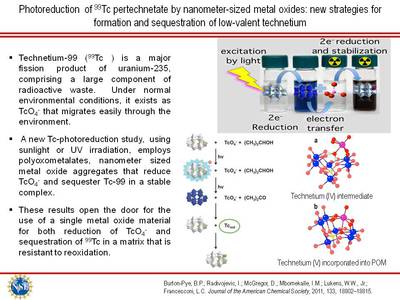Highlight Photo
Photoreduction of 99Tc pertechnetate by nanometer-sized metal oxides: new strategies for formation and sequestration of low-valent technetium
Photoreduction of Tc-99 pertechnetate by nanometer-sized metal oxides: new strategies for formation and sequestration of low valent technetium

Image describes the use of polyoxometalates (POMs), nanometer-sized metal oxides for reduction (in presence of sacrificial electron donor) of pertechnetate and formation of a Tc(IV) intermediate that slowly oxidizes to the Tc(V) and incorporates into the defect. The POM is promoted to an excited state by irradiation with light whereupon it picks up electrons and becomes blue (heteropolyblue). The blue reduced POM in turn reduces pertechnetate to Tc(IV) that binds to two oxygen atoms of the POM and slowly oxidizes and “snaps” into the POM defect. The POM defect supports a distorted octahedral Tc(V)=O environment with a short Tc=O bond and longer Tc-O (phosphate) interaction and 4 Tc-O bridging bonds. This provides a new approach to reduction of pertechnetate and sequestration of the resulting low valent Tc.
Credits: L. Francesconi, B. Burton-Pye





